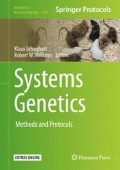Abstract
Diversity Outbred (DO) mice are a multiparental advanced generation intercross population derived from eight inbred strains which are genetically very diverse. They are maintained as an outbred population using a randomized mating design. Thus DO mice represent an ideal population to map phenotypic traits. Here, we provide a case study in which male DO mice were exposed to benzene and phenotyped for the number of micronucleated reticulocytes. We provide step-by-step R scripts for the analysis of phenotypes, genotypes, mapping of resistance gene loci and identification of candidate genes.
Access this chapter
Tax calculation will be finalised at checkout
Purchases are for personal use only
References
French JE, Gatti DM, Morgan DL, Kissling GE, Shockley KR, Knudsen GA, Shepard KG, Price HC, King D, Witt KL, Pedersen LC, Munger SC, Svenson KL, Churchill GA (2015) Diversity outbred mice identify population-based exposure thresholds and genetic factors that influence benzene-induced genotoxicity. Environ Health Perspect 123(3):237–245. doi:10.1289/ehp.1408202
Morgan AP, Fu CP, Kao CY, Welsh CE, Didion JP, Yadgary L, Hyacinth L, Ferris MT, Bell TA, Miller DR, Giusti-Rodriguez P, Nonneman RJ, Cook KD, Whitmire JK, Gralinski LE, Keller M, Attie AD, Churchill GA, Petkov P, Sullivan PF, Brennan JR, McMillan L, Villena F (2015) The mouse universal genotyping array: from substrains to subspecies. G3 (Bethesda) 6:263–279. doi:10.1534/g3.115.022087
Baud A, Hermsen R, Guryev V, Stridh P, Graham D, McBride MW, Foroud T, Calderari S, Diez M, Ockinger J, Beyeen AD, Gillett A, Abdelmagid N, Guerreiro-Cacais AO, Jagodic M, Tuncel J, Norin U, Beattie E, Huynh N, Miller WH, Koller DL, Alam I, Falak S, Osborne-Pellegrin M, Martinez-Membrives E, Canete T, Blazquez G, Vicens-Costa E, Mont-Cardona C, Diaz-Moran S, Tobena A, Hummel O, Zelenika D, Saar K, Patone G, Bauerfeind A, Bihoreau MT, Heinig M, Lee YA, Rintisch C, Schulz H, Wheeler DA, Worley KC, Muzny DM, Gibbs RA, Lathrop M, Lansu N, Toonen P, Ruzius FP, de Bruijn E, Hauser H, Adams DJ, Keane T, Atanur SS, Aitman TJ, Flicek P, Malinauskas T, Jones EY, Ekman D, Lopez-Aumatell R, Dominiczak AF, Johannesson M, Holmdahl R, Olsson T, Gauguier D, Hubner N, Fernandez-Teruel A, Cuppen E, Mott R, Flint J (2013) Combined sequence-based and genetic mapping analysis of complex traits in outbred rats. Nat Genet 45(7):767–775. doi:10.1038/ng.2644
Gaedigk A, Twist GP, Leeder JS (2012) CYP2D6, SULT1A1 and UGT2B17 copy number variation: quantitative detection by multiplex PCR. Pharmacogenomics 13(1):91–111. doi:10.2217/pgs.11.135
Hebbring SJ, Adjei AA, Baer JL, Jenkins GD, Zhang J, Cunningham JM, Schaid DJ, Weinshilboum RM, Thibodeau SN (2007) Human SULT1A1 gene: copy number differences and functional implications. Hum Mol Genet 16(5):463–470. doi:10.1093/hmg/ddl468
Acknowledgements
This work was supported by intra-mural grants from the Helmholtz-Association (Program Infection and Immunity) and a start-up grant from UTHSC awarded to KS and NIH grants GM076468 and GM070683 awarded to Gary Churchill of The Jackson Laboratory. The funders had no role in study design, data collection and analysis, decision to publish, or preparation of the manuscript.
Author information
Authors and Affiliations
Corresponding author
Editor information
Editors and Affiliations
1 Electronic Supplementary Materials
Rights and permissions
Copyright information
© 2017 Springer Science+Business Media New York
About this protocol
Cite this protocol
Gatti, D., French, J.E., Schughart, K. (2017). QTL Mapping and Identification of Candidate Genes in DO Mice: A Use Case Model Derived from a Benzene Toxicity Experiment. In: Schughart, K., Williams, R. (eds) Systems Genetics. Methods in Molecular Biology, vol 1488. Humana Press, New York, NY. https://doi.org/10.1007/978-1-4939-6427-7_12
Download citation
DOI: https://doi.org/10.1007/978-1-4939-6427-7_12
Published:
Publisher Name: Humana Press, New York, NY
Print ISBN: 978-1-4939-6425-3
Online ISBN: 978-1-4939-6427-7
eBook Packages: Springer Protocols

